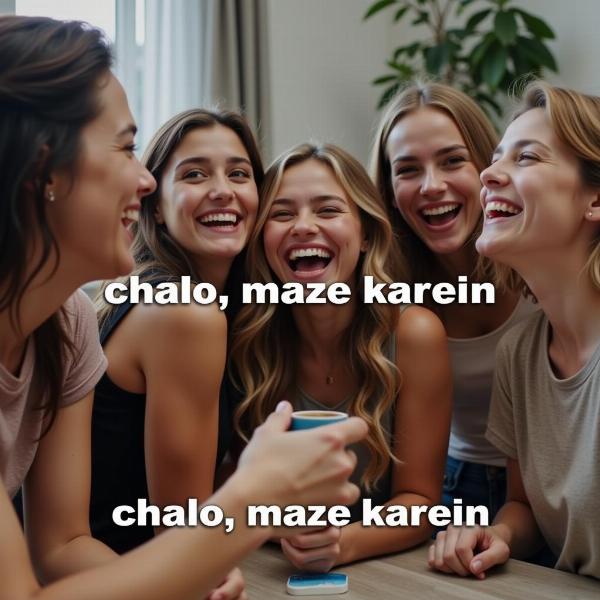Understanding the nuances of “let’s have fun” in Hindi enriches our cross-cultural communication and allows us to connect more deeply with the vibrant Indian culture. This phrase, often used to initiate leisure activities and express a desire for enjoyment, has several Hindi equivalents that capture different shades of meaning. Let’s delve into the various ways to express “let’s have fun” in Hindi, exploring the cultural context and providing practical examples.
Different Ways to Say “Let’s Have Fun” in Hindi
The Hindi language offers a rich tapestry of expressions to convey the sentiment of having fun. The best translation depends on the specific context, level of formality, and the relationship between the speakers.
- Chalo, maze karein (चलो, मज़े करें): This is a common and versatile expression suitable for most informal situations. “Chalo” means “let’s go,” while “maze karein” means “let’s have fun.”
- Chalo, khushi manayein (चलो, खुशी मनाएँ): This phrase translates to “let’s celebrate happiness” and is often used for festive occasions or celebrations.
- Aao, anand lein (आओ, आनंद लें): This expression translates to “come, let’s enjoy” and carries a slightly more formal tone, suitable for inviting guests or elders.
- Masti karein (मस्ती करें): “Masti” refers to fun and enjoyment, making this phrase a concise and informal way to say “let’s have fun.”
- Khel kud karein (खेल कूद करें): This phrase emphasizes playful activities and is ideal for suggesting games or physical recreation.
Choosing the Right Expression
The specific situation and your relationship with the other person play a crucial role in selecting the appropriate Hindi phrase. Using “aao, anand lein” with close friends might sound overly formal, while using “masti karein” with elders might appear disrespectful.
 Friends laughing and enjoying themselves
Friends laughing and enjoying themselves
Beyond Literal Translations: Cultural Context
Understanding the cultural context is crucial for effective communication. In India, communal enjoyment and shared experiences are highly valued. Therefore, phrases like “let’s have fun” often imply a collective activity, emphasizing togetherness and shared joy.
Let’s Have Some Fun: Examples in Action
Imagine you’re inviting your friends to a cricket match: “Chalo, maze karein, aaj cricket match hai!” (Let’s have fun, there’s a cricket match today!). Or, if you’re planning a family picnic, you could say: “Chalo, khushi manayein, aur picnic pe chalte hain!” (Let’s celebrate happiness and go on a picnic!).
Incorporating Fun into Everyday Life
Indians have a knack for finding joy in simple things, from sharing chai with friends to celebrating festivals with gusto. This cultural emphasis on enjoyment reflects in the language, providing a diverse range of expressions for “let’s have fun.”
How do you say “let’s have some fun” in casual Hindi?
Masti karein! This is a short, sweet, and commonly used phrase for casual settings.
What is a formal way to say “let’s have fun” in Hindi?
Aao, anand lein is a more respectful and formal way to express the sentiment.
How do you invite someone to a playful activity in Hindi?
Khel kud karein emphasizes playful interaction and is perfect for suggesting games or physical activity.
Conclusion: Embracing the Joy of Hindi
Learning to express “let’s have fun” in Hindi opens doors to deeper cultural understanding and connection. By choosing the right phrase and understanding the context, you can communicate effectively and share in the joy of Indian culture. Remember, language learning is a journey of discovery, and embracing the nuances of Hindi adds richness and depth to the experience.
FAQs
- What is the most common way to say “let’s have fun” in Hindi? Chalo, maze karein is widely used and suitable for most informal situations.
- Is “masti karein” polite to use with elders? While commonly used amongst friends, using masti karein with elders might be considered informal. Opt for a more respectful phrase like aao, anand lein.
- How do I express the idea of “having a blast” in Hindi? You can use phrases like “bahut maze karenge” (बहुत मज़े करेंगे) or “dhoom machayenge” (धूम मचाएंगे) to convey the idea of having a blast.
- What’s the difference between “maze karein” and “khushi manayein”? While both express enjoyment, khushi manayein emphasizes celebrating happiness, often used for festive occasions, while maze karein is a more general term for having fun.
- Can I use these phrases in any part of India? Yes, these phrases are commonly understood across most Hindi-speaking regions of India. However, regional dialects might have their own variations.
Meaning-Hindi.in specializes in accurate and culturally sensitive Hindi translation services, catering to a diverse range of needs, from business documents to educational materials. Whether you need website localization or legal document translation, our expert team ensures precise and reliable results. Contact us today for all your Hindi translation needs at [email protected] or call us at +91 11-4502-7584. Meaning-Hindi.in is your trusted partner for bridging language barriers and connecting cultures.